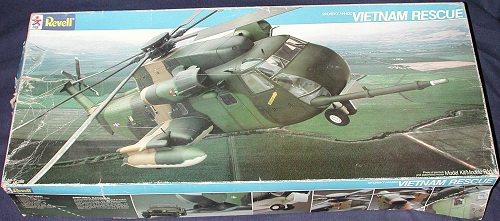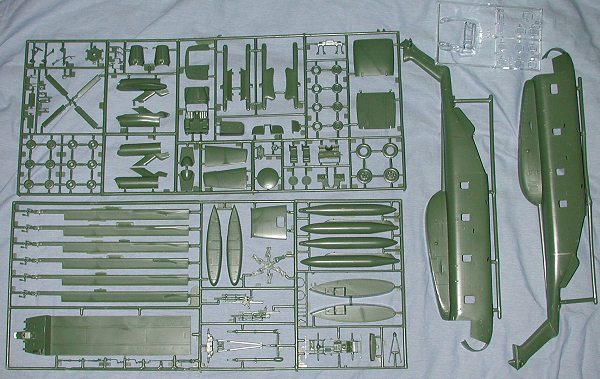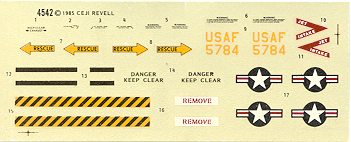
|
KIT: |
Revell 1/48 HH-53C |
|
KIT # |
4542 |
|
PRICE: |
$ |
|
DECALS: |
One aircraft |
|
REVIEWER: |
|
|
NOTES: |

|
HISTORY |
Using much of the experience gained with the S-61 and the dynamic components (rotor, transmission and anti-torque rotor) of the S-64 flying crane, Sikorsky designed a new family of helicopters designated S-65, various versions of which have been developed. On the basis of the S-61R project for the Marines, the American company proposed the S-65A with a completely redesigned, large-capacity fuselage, capable of transporting 37 equipped troops or 24 stretchers with 4 medical attendants. The US Navy, which is responsible for acquisitions for the Marines, announced the choice of the S-65A in August 1962.
The CH-53 Sea Stallion had the six-blade rotor and tail rotor of the S-64 flying crane, driven through the same transmission by new General Electric T64 engines. The fuselage no longer had the boat-type hull of the S-61, although it could land on water with two stub wings acting as stabilizers and containing the fuel tanks and, at the back, the bay for the fully retractable main landing gear units. The cargo hold, equipped with a loading ramp and an automatic loading and unloading system (which can be operated even when the helicopter is in flight), can take two jeeps, antiaircraft missiles with their fire control systems or a 105mm howitzer.
The first Sea Stallion flew on 14 October 1965, and delivery of the first 106 helicopters began in September 1966. The aircraft were assigned to Marine Squadron HMH-463 in Vietnam in January 1967. At that period, it was the largest helicopter in the Western world. On 17 February 1968, a CH-53A with modified T64 engines took off with a gross weight of 23540kg and a 9925kg payload, establishing an unofficial record. On 23 October of the following year a Sea Stallion demonstrated surprising maneuverability when it performed a series of loops and rolls with Lt.-Col. Robert Guay of the Marines and Sikorsky test pilot Byron Graham at the controls, carrying a gross weight of 12250kg. During these maneuvers, the helicopter supported from -0.2 to 2.8g.
The Sea Stallion also aroused some interest in other countries where there was a requirement for a helicopter for troop transport. Thus the S-65A was also ordered by Germany, where it was built under license by VFW-Fokker as the CH-53G. Another eight aircraft, modified for use in hot/high conditions, were exported to Israel.
In September 1966, the USAF also ordered this big helicopter for its rescue service to assist space programs and recover pilots from war zones. The eight HH-53B ordered for the USAF were known as "Super Jolly Green Giants" and fitted with in-flight refueling probes, jettisonable auxiliary fuel tanks, rescue hoists and all-weather avionics. Fifty-eight of the subsequent HH-53C variant with uprated turbines (3435shp each) were built. After having used the early production aircraft, the US Marine Corps also asked for more powerful engines to be installed, and the result was the CH-53D with 3925shp T64-GE-423 engines. In this version, the tail and rotor could be folded back automatically, and a high density cabin layout was available to accommodate 64 troops, equivalent to the S-65C export version. A total of 265 CH-53As and Ds were built for the Marines; the last left the factory on 31 January 1972. Since then, the aircraft has been upgraded and updated several more times for various missions, including mine-sweeping. It is still the best heavy-lift helo in US service.
|
THE KIT |

A bit of an oldie, but a goodie, the Revell HH-53C has been produced in other guises, but it is the Jolly Green one that garners the most interest amongst modelers. Molded in an olive green, this kit has superb rivet detail and consists of mostly raised lines; not unusual in this 1985 boxing. It comes with a relatively complete cockpit that includes rudder pedals and what appears to be both cyclic and collective controls. There is a large cargo area with a rear ramp that is designed to be moveable. The kit also includes external fuel tanks and a Jeep with 105mm howitzer are included for a load.
I saw a few sink marks and, of course, there are ejector pin marks on a lot of smaller pieces, some of which will not be fun to eradicate. Most of the sink marks are in benign areas; care being needed to fill them without trashing the rivet detail around them. Though I've not built this kit, it seems to me that fit should be on a par with contemporary Monogram kits, meaning you'll need to build with care and have filler standing by.
 Instructions are the usual pictorial sections with only generic names given to
the paints. Color info is given during the construction sequences and the parts
are named, which is rather nice. I know that some reviewers used to go on and on
about how horrible it was that pieces were not identified. Frankly, it doesn't
bother me not knowing what a bit is, but it is nice to have that info. Decals
are for a generic aircraft as shown on the box art. I'm not sure if these guys
carried any distinctive unit markings or not. Helos are not my forte.
Instructions are the usual pictorial sections with only generic names given to
the paints. Color info is given during the construction sequences and the parts
are named, which is rather nice. I know that some reviewers used to go on and on
about how horrible it was that pieces were not identified. Frankly, it doesn't
bother me not knowing what a bit is, but it is nice to have that info. Decals
are for a generic aircraft as shown on the box art. I'm not sure if these guys
carried any distinctive unit markings or not. Helos are not my forte.
|
CONCLUSIONS |
I've seen these built up and they are extremely impressive models. An average modeler should not have any problem building this out of the box and I know that there are lots of expensive aftermarket resin sets to make the latest and greatest versions of this helo out there. If you want a big H-53, here you go!
|
REFERENCES |
G.Apostolo "The Illustrated Encyclopedia of Helicopters", 1984
If you would like your product reviewed fairly and fairly quickly by a site that has well over 175,000 visitors a month, please contact me or see other details in the Note to Contributors.